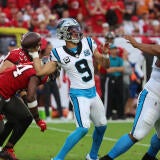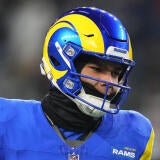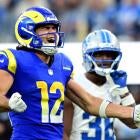Rewind: Greensboro doctors developing hand-held concussion test
Researchers and doctors at the Joint School in Greensboro, North Carolina are developing a hand-held concussion test that could help in-game medical analysis.
By
Will Brinson
•
5 min read
 |
| Collie is carted off the field after a nasty concussion injury. (Getty Images) |
This article previously appeared in February of 2011. As part of our examination into the NFL making the game safer against concussions (read Mike Freeman's list of 10 things the NFL can do to make the game safer here), we're hopping in the wayback machine. Join us.
The NFL announced a new concussion protocol procedure for teams on Friday in Indianapolis. But the answer to one of the league's most significant problems might actually be residing in Greensboro, N.C.
It's there, nearly 600 miles away from where the next batch of players is showing off their skills at the combine, that development to diagnose concussions with a handheld test is getting underway.
You can't actually diagnose a concussion, or traumatic brain injury, without knowing what happened inside the body. And this is important because it relates to the NFL's recent announcement of moving to a standardized examination. A positive step, but it's not going to allow medical staffs to make 100 percent accurate diagnostics.
That's where the Join School of Nanoscience and Nanoengineering, a collaborative effort between the University of North Carolina at Greensboro and N.C. A&T State University, comes in.
"There are no diagnostic tools to accurately measure the neurological changes [following a concussion]," Shyam Aravamudhan, a JSNN professor, told CBSSports.com when we visited the facility earlier this year. "Molecular changes are where symptoms can be accurately diagnosed."
And the NFL's decision to use a universal baseline test will certainly aid in that area, but, again, not to the degree of certainty with which a molecular test would.
The process by which blood-based diagnosis occurs is fascinating. The brain contains a series of barriers that prevent entry by various molecular components to portions of the gray matter that help us function each day. Those barriers can be broken when an individual suffers a concussion, and as a result of the barriers breaking, markers are released into the blood stream. And when an individual is tested in the manner using the JSNN device, a positive test for markers indicates a case of traumatic brain injury.
A reasonable example of comparison is someone who gets busted for a DUI. Ever have a friend who almost never, ever acts drunk regardless of how much alcohol he's consumed? That person could get behind the wheel of a car after drinking 12 beers in the span of 4 hours and appear sober.
That has nothing to do with how much alcohol is in his bloodstream, it's merely a symptom of his body's different chemical makeup and how it processes alcohol. So everyone involved -- particularly the cop -- is surprised when he blows a .22 despite passing all the field-sobriety tests.
Want an on-the-field example? Remember the monster shot Austin Collie took against the Eagles when Asante Samuel launched him into inadvertent helmet-to-helmet contact with Kurt Coleman? Well, Collie didn't play for a few weeks because of the hit and finally returned to the field in Week 12, only to show "concussion symptoms" within the first few plays.
In other words he appeared completely fine to the critical eye, at least leading up to the game. An objective test of Collie's blood probably would have indicated these "concussion markers" from TBI were present and kept him off the field entirely.
Traumatic brain injury sounds much worse than "concussion." But it's important to note that according to the JSNN's staff between 75 and 90 percent of the 1.9 million annual diagnosed cases of TBI (per the Center for Disease Control's research) are "mild."
"Mild" doesn't mean "safe" by any stretch of the imagination, and it's in this category where most sports concussions fall. But the most terrifying thing about these "mild" injuries is that as the frequency with which they occur increases, so does the long-term damage.
"Military and sports personnel are high-risk individuals," Kristine Lundgren, associate professor at UNCG's School of Health and Human Performance said. "With a second incident of TBI, the severity is even worse."
There are countless cases, according to the JSNN, of soldiers being incorrectly diagnosed with post-traumatic stress disorder when they've actually suffered a number of concussions. The symptoms -- from depression to delirium -- are similar but the treatment and, most importantly, prevention, are completely different.
"Why would you let the fact that the individual is conscious overrule what you find?" said Dr. Vince Henrich, director of biotechnology, genomics and health resources at UNCG. "There's a confusion about consciousness -- [when someone's awake] it's too easy to conclude that everything's okay."
And individual brains are, unsurprisingly, quite different from person to person, making a diagnosis even more difficult.
"You have to know the player, you have to know what they were like before," Lundgren said. "It's a really tough thing to do."
What we do know is concussions are this generation's -- for NFL players and beyond -- "signature injury." That's why funding for this type of research is so critical. The JSNN staff estimated that the work needed for an in-the-field concussion test that can determine TBI based on molecular levels could be completed in "about four years." In-the-field being something military and sports professionals could bring to their respective worlds.
But they also said, "depending on funding," it could be completed much faster. Dean Jim Ryan classified the UNC Greensboro's work on TBI as "one of the most immediately understood goals."
That's not an endorsement for any sort of investment, but it's obvious that current standards for measuring TBI in the NFL don't precisely meet the needs of an increasingly dangerous sport.
And yes there are also obvious issues aside from money. Players might have serious issues using bodily fluids for tests like this if the NFL controlled it.
But when you see someone like Dave Duerson -- an NFL legend dedicated to helping improve medical assistancefor former players -- scrawl words about using his brain for science on his suicide note , it's hard not to think there's more that can be done immediately to improve the quality of life for not just current players but the kids who will eventually make their way onto NFL fields.
"TBI is more dangerous to a young brain," Lundgren said. "The brain is still developing and therefore at more risk."
Because concussions aren't exactly selective, everyone on the football field's at risk until science figures out a way to really get a handle on what's going on inside our heads.
For more NFL news, rumors and analysis, follow @EyeOnNFL on Twitter, subscribe to our RSS Feed and subscribe to our Pick-6 Podcast and NFL newsletter. You can follow Will Brinson on Twitter here: @willbrinson.

















